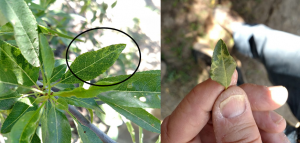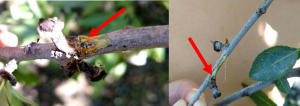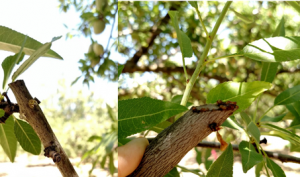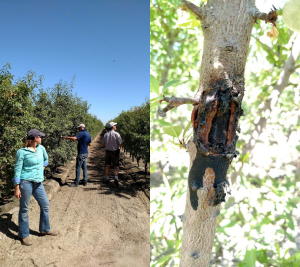As farm advisors, we work hard to keep up on each other’s research, maintain relationships with faculty and specialists located in other parts of the state, and keep an eye on what growing trends are in other regions. One of the ways we do this is a farm advisor training tour, rotated to a different county/region each year. For 3 days last week, roughly 30 advisors, faculty and scientists met in Kern county for an almond tour. Below are some photos from a few of the orchards that we visited.

Chlorotic spotting (left, circled) and oak-leaf pattern (right) leaf symptoms on trees infected with almond calico (PNRSV). Click to enlarge. Photo: D. Lightle.
Almond calico symptoms include spots or oak-like patterns on the leaves. They tend to show up more in the spring when the weather is cooler, and will typically fade as the temperatures get more hot. It is caused by a virus, Prunus Necrotic Ringspot Virus (PNRSV). Certain strains of PRNSV can also cause infectious bud failure (not to be confused with non-infectious bud failure, the cause of crazy top symptoms most typically associated with Carmel). The virus can be transmitted in pollen, but can also frequently be traced back to the use of infected budwood when grafting.

Red arrows point to black streaking under the bark of dead spurs. The presence of this streaking indicates a hull rot strike from a previous growing season. Click to enlarge. Photo: D. Lightle.
Hull rot has become an increasing problem at harvest for some growers. Unlike the main pathogens involved in hull rot in the Sacramento Valley growing region (Monolinia and Rhizopus), one of the main causal agents in Kern county is a species of Aspergillus fungi. May is a bit early to see current season hull rot strikes; however, if you suspect that strikes from last season contributed to dead spurs this season, use your knife to cut under the bark on the proximal side of the spur (side towards the tree) and look for black streaking like in the photos above.

Clear and amber gumming on these pruning wounds indicate that infection may be beginning. Dr. Trouillas will sample each of these pruning wounds and to evaluate fungicide efficacy. See text for more information. Photo: D. Lightle.
Dr. Florent Trouillas, one of our plant pathology specialists located at Kearney Ag Center, introduced us to a research project he is beginning to evaluate fungicides that may help prevent infection of pruning wounds by various canker-causing fungi such as Ceratocystis or Botryosphaeria. His study involved making smaller pruning cuts on a tree, treating with a fungicide, followed by inoculation of the pruning wound with fungal spores. Later this summer, he will examine each of the pruning cuts for signs of infection and attempt to re-isolate the pathogen. As seen in the above photos, some of the pruning wounds are beginning to show signs of gumming & disease.

Hedgerow almonds (left) are kept short – these 5th leaf trees are between 6 and 7 feet tall. Harvest damage (right) from prior harvests were frequently encountered. Click to enlarge. Photo: D. Lightle.
A new planting style you may have encountered through word of mouth is hedgerow planting. These high-density almond plantings on Rootpac 20 (a dwarfing rootstock from Agromillora) are hedged and topped yearly to maintain approximately 3 foot width and a height between 6 and 7 feet. This particular planting is going into its 5th leaf. One problem the grower had encountered was difficulty in contracting for harvest equipment (typically an OxBo olive harvester) — use of a grape harvester in previous seasons caused significant damage on many of the scaffolds because the heads were adjusted too close.


Leave a Reply